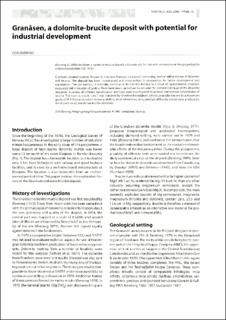| dc.contributor.author | Øvereng, Odd | |
| dc.coverage.spatial | 18261 Mosjøen | |
| dc.date.accessioned | 2020-08-26T09:08:36Z | |
| dc.date.available | 2020-08-26T09:08:36Z | |
| dc.date.issued | 2000 | |
| dc.identifier.uri | https://hdl.handle.net/11250/2674212 | |
| dc.description.abstract | Granåsen, situated close to Mosjøen in northern Norway, is a deposit containing several million tonnes of dolomite and brucite. The deposit has been investigated and characterised in preparation for future development and exploitation. The ore consists of dolomite and brucite. Brucite has formed as a result of hydrothermal alteration associated with intrusion of gabbro. Tests have been carried out to evaluate the commercial value of the dolomite resources. A variety of different benefication methods were investigated to achieve commercial concentrates of brucite. The most successful result was obrained by selective flocculation, which up-grades the ore to a maximum grade of 95.5% brucite, with a revovery of 80%. As an alternative, or by-product of brucite concentrate production, the deposit could also be worked for dolomite. | |
| dc.language.iso | eng | |
| dc.relation.ispartofseries | NGU Bulletin (436) | |
| dc.rights | Navngivelse 4.0 Internasjonal | |
| dc.rights.uri | http://creativecommons.org/licenses/by/4.0/deed.no | |
| dc.subject | GEOLOGISK UNDERSØKELSE | |
| dc.subject | BRUCITT | |
| dc.subject | MINERALFOREKOMST | |
| dc.subject | OMVANDLING | |
| dc.subject | DOLOMITT | |
| dc.title | Granåsen, a dolomite-brucite deposit with potential for industrial development. | |
| dc.type | Journal article | |
| dc.description.localcode | 49530 | |
| dc.source.pagenumber | 75-84 | |

